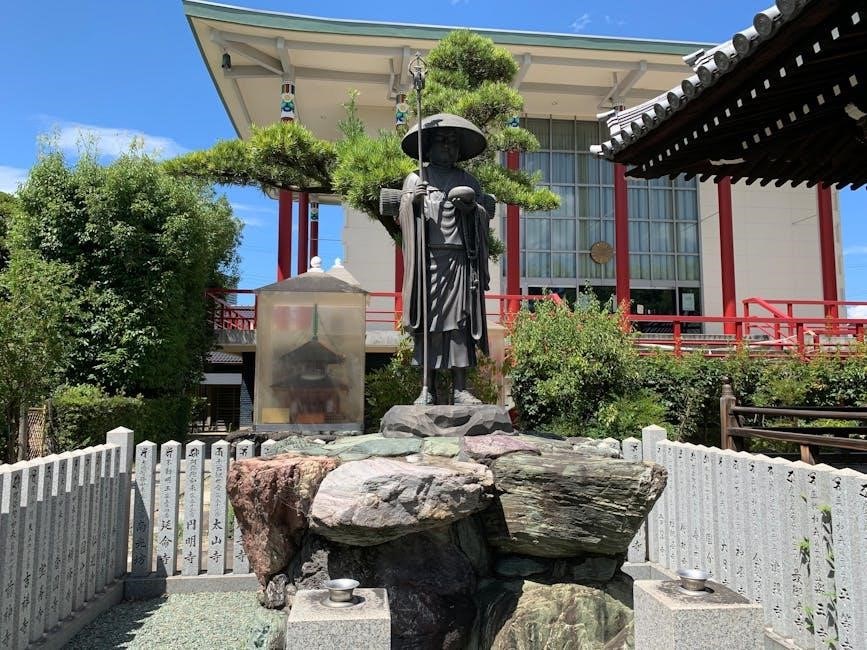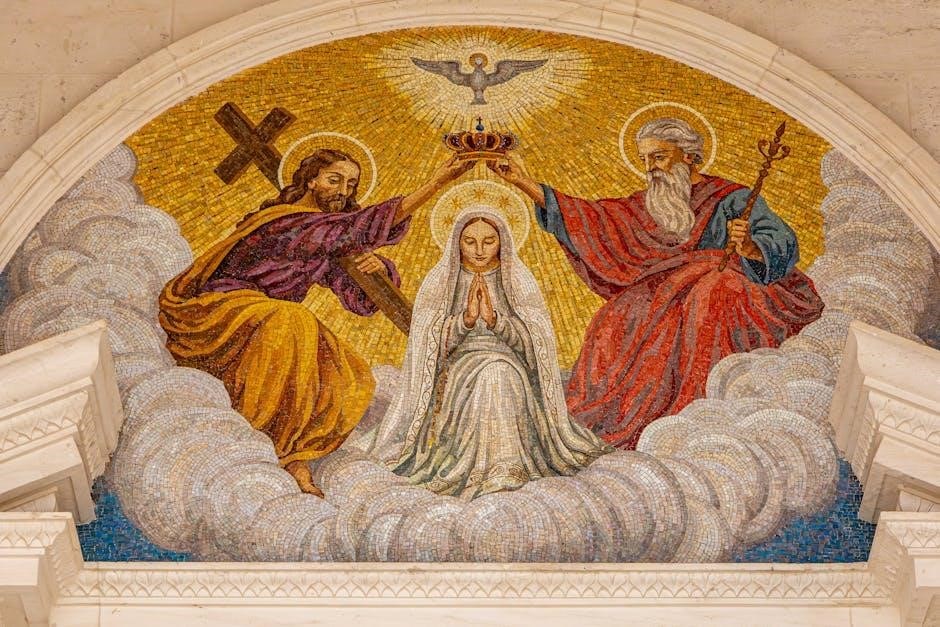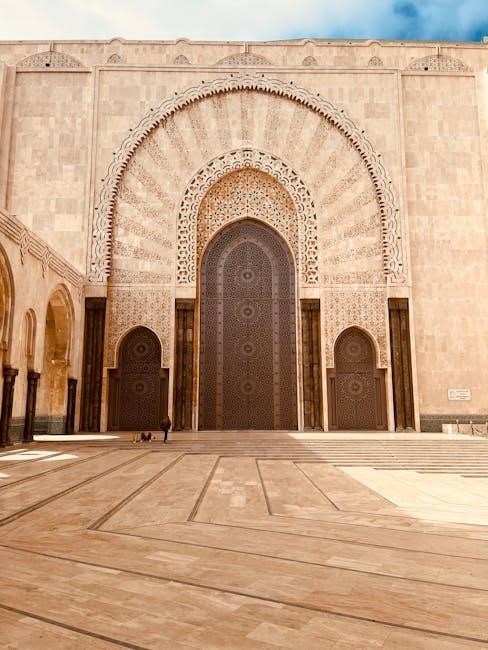The Mincha prayer, or afternoon service, is a vital part of Jewish daily worship, recited between midday and sunset․ Its structure includes the Amidah, blessings, and additional texts, reflecting spiritual reflection and connection․ English translations and PDF resources are widely available for those seeking to deepen their practice․
Overview of the Mincha Prayer
The Mincha prayer, or afternoon service, is a central part of Jewish daily worship, observed between midday and sunset․ It includes the Amidah, blessings, and additional readings, focusing on spiritual reflection and connection․ English translations and PDF resources are widely available, making it accessible for those seeking to deepen their practice․ The prayer emphasizes gratitude, forgiveness, and divine mercy, serving as a moment of pause amidst daily activities to reconnect with faith and community․
Significance of the Mincha Prayer in Jewish Tradition
The Mincha prayer holds profound significance as the afternoon service in Jewish tradition, offering a moment of reflection and connection with the divine․ It is one of the three daily prayers, emphasizing gratitude, forgiveness, and divine mercy․ The Amidah, a central component, is recited silently, fostering personal introspection․ Mincha provides an opportunity to pause and reaffirm faith amidst daily activities․ Its accessibility through English translations and PDF resources ensures it remains a vital practice for Jews worldwide, maintaining a spiritual connection and fostering community bond, even in challenging times․
Structure of the Mincha Prayer
The Mincha prayer includes the Amidah, core of the service, blessings preceding and following it, and additional texts like Psalms, creating a structured yet meaningful worship experience․
The Amidah: The Core of the Mincha Prayer
The Amidah, or “Standing Prayer,” is the heart of the Mincha service, recited silently while standing․ It consists of 19 blessings on weekdays, addressing praise, requests, and gratitude․ The Amidah is divided into three sections: praise of God, requests for wisdom and forgiveness, and expressions of thanksgiving․ During Mincha, the Amidah is recited with a focus on mindfulness and intention, connecting the individual to the divine․ English translations of the Amidah are widely available in prayer books and PDF formats, enabling worshippers to engage deeply with the text․ Its structure and content reflect the Jewish tradition of prayer as a dialogue with God․
Blessings and Prayers in the Mincha Service

The Mincha service includes a series of blessings and prayers that frame the worship experience․ It begins with opening blessings, followed by the Shema and its accompanying verses, which express loyalty to God․ The service also includes prayers for healing, sustenance, and divine mercy․ The closing section features the Aleinu prayer, affirming the uniqueness of God and the hope for redemption․ These prayers, rooted in Torah and Prophets, are recited in both Hebrew and English, with translations widely available in PDF formats․ They reflect the spiritual and communal aspects of Jewish prayer, fostering connection and introspection during the afternoon hours․
Additional Readings and Texts in Mincha
Beyond the core prayers, the Mincha service includes additional readings that enhance its spiritual depth․ Many traditions include scanning Zohar texts before beginning the prayer, believed to bring divine mercy․ The service also incorporates the recitation of Ashrei, a joyful psalm from Psalm 145, and selections from the Torah and Prophets, especially on Shabbat and holidays․ These readings provide a richer connection to Jewish scripture and tradition․ English translations of these texts are widely available in PDF formats, making them accessible for those who prefer praying in English while maintaining the service’s authenticity and spiritual significance․
How to Pray Mincha
To pray Mincha, begin between midday and sunset․ Recite the Amidah, the core prayer, and additional readings․ Use an English PDF for guidance, ensuring clarity and focus during the service․
When and Where to Recite the Mincha Prayer
The Mincha prayer is traditionally recited between midday and sunset, with the optimal time being after halachic noon․ It can be said at home, in a synagogue, or outdoors, but preferably in a quiet, sacred space․ The use of an English PDF guide can aid those unfamiliar with Hebrew, ensuring proper recitation and understanding․ Praying with a minyan in a synagogue is ideal, but individual prayer is also acceptable when necessary․ The service should be conducted with focus and respect, avoiding distractions to maintain its spiritual significance․
Preparation for the Mincha Prayer

Preparation for Mincha involves ensuring a quiet, sacred space for focus․ One should wash hands ritually, dress modestly, and avoid distractions․ For non-Hebrew speakers, using an English PDF guide can facilitate understanding․ It is customary to recite verses or Zohar texts before starting․ Some also sip water to cleanse their thoughts; The service begins with Ashrei and Korbanot, followed by the Amidah․ Mental preparation, such as reflecting on one’s actions, enhances the prayer’s spiritual impact․ Proper posture and concentration are essential to connect deeply with the service․ Ensuring timely recitation, ideally before sunset, is crucial for fulfilling the daily obligation meaningfully․
A Step-by-Step Guide to the Mincha Service
The Mincha service begins with opening prayers, including Ashrei and Korbanot, which set a sacred tone․ The Amidah follows, recited silently while standing, focusing on gratitude, forgiveness, and divine mercy․ After the Amidah, the Tachanun prayer is recited on weekdays; Concluding prayers include Alyenu and Shir Shel Ya’akov․ For those using an English PDF guide, the translations align with Hebrew texts, aiding comprehension․ The service ideally concludes before sunset, ensuring adherence to the daily obligation․ Proper concentration and posture enhance the spiritual experience, fostering a deeper connection to the divine and the tradition of Jewish prayer․

Mincha Prayer in English
The Mincha prayer in English is readily available online, offering convenient PDF downloads for easy access and recitation․ These resources provide clear translations, aiding spiritual practice and understanding․
English Translations of the Mincha Prayer
English translations of the Mincha prayer are widely available, offering accessibility for those who prefer or need to pray in English․ These translations maintain the original Hebrew meaning while providing a clear and understandable version for English speakers․ Many Jewish organizations, such as Chabad and Sefaria, offer free downloadable PDF versions of the Mincha prayer in English․ These resources often include transliterations of key Hebrew phrases, ensuring that even those unfamiliar with Hebrew can participate fully․ The translations are carefully crafted to preserve the spiritual depth and intent of the original text, making the Mincha prayer accessible to a broader audience worldwide․

Resources for Downloading Mincha Prayer in English PDF
Several reputable Jewish organizations offer free downloadable PDF versions of the Mincha prayer in English․ Chabad and Sefaria provide comprehensive resources, including transliterations and translations, to accommodate both Hebrew and English speakers․ These PDFs are formatted for easy reading and often include instructions for proper prayer recitation․ Additionally, websites like Ashkenaz and Sefard provide version-specific texts, ensuring accessibility for diverse Jewish communities․ These resources are ideal for individuals seeking to deepen their spiritual practice or for educational purposes, making the Mincha prayer readily available to anyone with internet access․

Benefits and Spiritual Significance

The Mincha prayer fosters mindfulness, connecting us with the divine during the busiest part of the day․ It offers a moment of reflection, balancing work and spirituality, and provides tranquility․ English resources enhance accessibility for deeper engagement and spiritual growth․
Spiritual Reflections During Mincha
During Mincha, individuals engage in profound spiritual reflection, focusing on gratitude and divine connection․ The prayer’s timing, between midday and sunset, symbolizes a transition from activity to introspection․ Many find solace in the English translations of Mincha prayers, which facilitate a deeper understanding and personal connection․ The service encourages mindfulness, allowing practitioners to pause amidst daily routines and reconnect with their faith․ This reflective practice not only rejuvenates the spirit but also fosters a sense of balance and harmony in one’s life․ The availability of Mincha prayer PDFs in English further enhances accessibility for those seeking spiritual enrichment․
The Role of Mincha in Daily Jewish Life
The Mincha prayer plays a central role in daily Jewish life, serving as a spiritual anchor between morning and evening․ It provides a moment of reflection and connection to the divine amidst the day’s activities․ For many, Mincha is a source of comfort and balance, offering an opportunity to express gratitude and seek guidance․ Its adaptability to various schedules makes it accessible, even for those with busy lives․ By incorporating English translations, such as those found in Mincha prayer PDFs, individuals can deepen their engagement, fostering a stronger relationship with their faith and community․ This prayer is a vital part of Jewish daily worship and spiritual renewal․

Common Mistakes to Avoid
Common errors include praying Mincha after sunset, neglecting proper preparation, and rushing through the service․ Ensure timely recitation and maintain focus for a meaningful experience․
Understanding the Timing of Mincha
The timing of Mincha is crucial, beginning approximately half an hour after midday and concluding before sunset․ It is essential to avoid praying after dark, as this falls under Maariv․ Proper calculation of the correct time ensures the prayer’s validity․ Resources like calendars or digital tools can aid in accurate timing․ Understanding the precise window for Mincha helps maintain its sanctity and alignment with Jewish tradition․ Praying within the designated period is vital for fulfilling the daily obligation effectively․
Proper Etiquette During the Mincha Prayer
Proper etiquette during Mincha ensures a respectful and focused prayer experience․ It is customary to face Jerusalem, maintain a clean and modest attire, and avoid interruptions․ Speaking during the service is discouraged, and one should stand with feet together during the Amidah․ Men are required to wear a tallit and kippah, while women should dress modestly․ Avoiding distractions, such as turning off phones, helps in maintaining concentration․ These practices enhance the spiritual atmosphere and reflect reverence for the prayer’s significance in Jewish tradition․

Mincha in Jewish Tradition
Mincha, rooted in Torah and Talmud, reflects Jewish tradition’s emphasis on daily worship․ Observed between midday and sunset, it connects Jews globally, fostering spiritual unity and mindfulness, with English resources available for diverse observance․
Mincha in the Context of Shabbat and Holidays
During Shabbat and Jewish holidays, the Mincha prayer takes on unique significance, often including special additions and heightened spiritual intent․ On Shabbat, Mincha is recited Friday afternoon before sunset, incorporating songs and readings that reflect the day’s sanctity․ Holidays similarly enrich the Mincha service with additional prayers and Torah readings, emphasizing communal connection and joy․ English translations of these prayers are readily available in PDF formats, making it accessible for all to participate fully․ These resources ensure that the traditions and meanings of Mincha during special times remain vivid and meaningful for those observing them․
Cultural and Historical Aspects of Mincha
The Mincha prayer holds deep cultural and historical significance, tracing its origins to the patriarchal era and the afternoon sacrifices in the Temple․ Over centuries, it evolved through Talmudic discussions and Rabbinic contributions, becoming a cornerstone of Jewish daily life․ Its structure reflects a blend of ancient traditions and spiritual practices, with the Amidah serving as its core․ Culturally, Mincha bridges generations, connecting Jews worldwide through shared rituals and texts․ English translations, like those found in PDF resources, ensure accessibility, preserving its heritage while adapting to modern needs․ This prayer embodies both historical continuity and vibrant, living tradition․
Learning and Growth
Learning Mincha enriches spiritual growth, with English PDF resources offering translations and insights, helping beginners and seasoned practitioners deepen their connection to the prayer’s meaning and tradition․
Learning the Mincha Prayer for Beginners
Learning the Mincha prayer is a meaningful journey for beginners, especially with English translations and guides available in PDF formats․ Start by understanding the structure, focusing on the Amidah and key blessings․ Use resources like the Chabad Mincha prayer in English PDF for clear transliterations and translations․ Practice reciting the prayers slowly, connecting with their meanings․ Begin with the English version to build familiarity, then gradually incorporate Hebrew․ Utilize step-by-step guides to master the order and nuances of the service; Engage with community resources or online tutorials for additional support․ Consistency and reflection will deepen your understanding and connection to the Mincha prayer․

Deepening Your Connection Through Mincha
Deepening your connection through Mincha involves understanding its spiritual essence and integrating it into daily life․ Focus on the prayer’s meaning, especially the Amidah, which fosters gratitude and mindfulness․ Use English translations of the Mincha prayer to enhance comprehension and emotional engagement․ Reflect on the blessings, acknowledging divine guidance and seeking balance in life․ Incorporate personal intentions, making the prayer a dialogue with the divine․ Practice mindfulness during the service, allowing the words to resonate deeply․ Engage with communal prayer when possible, as shared experiences enrich spiritual growth․ Regular reflection and study of the prayer’s texts can further nurture your connection to Mincha․
The Mincha prayer holds profound significance as a daily spiritual practice․ English PDF resources make it accessible for meaningful worship․ Its enduring value enriches Jewish tradition and daily life․
The Enduring Importance of Mincha
The Mincha prayer remains a cornerstone of Jewish worship, offering a moment of reflection amidst the day’s chaos․ Its enduring importance lies in its ability to connect individuals with their faith, fostering gratitude and mindfulness․ English translations and PDF resources have made Mincha accessible to a broader audience, ensuring its traditions are preserved․ Regular observance of Mincha strengthens spiritual resilience and communal bonds, highlighting its timeless relevance in modern Jewish life․ By embracing Mincha, one nurtures a deeper connection to heritage and spirituality, contributing to the continuity of this sacred practice for future generations․
Final Thoughts on the Mincha Prayer
The Mincha prayer holds enduring value as a spiritual anchor in daily life, offering moments of reflection and connection to faith․ Access to English translations and PDF resources has made it more accessible, fostering deeper engagement for diverse worshippers․ Embracing Mincha nurtures mindfulness, gratitude, and resilience, reinforcing its significance in Jewish tradition․ By incorporating Mincha into one’s routine, individuals can strengthen their spiritual practice and uphold a meaningful legacy for future generations․ Its universal themes and timeless relevance ensure Mincha remains a cherished part of Jewish worship, transcending time and circumstance․


